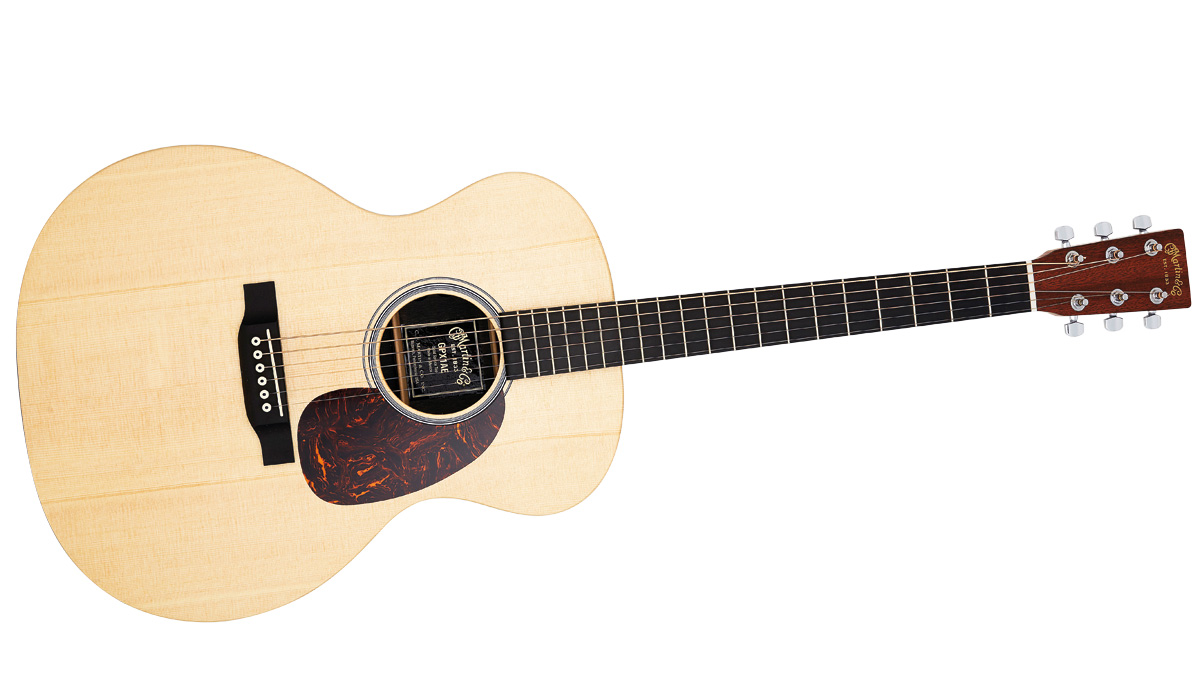MusicRadar Verdict
Superbly built and a surprisingly good sound for live or recording duties. The GP is a great bet for a main guitar choice, or a second as a spare or alternately tuned.
Pros
- +
An all-rounder. Compact. USB output is handy.
Cons
- -
The plastic-mounted output jack and plastic strap button don't fill us with confidence.
MusicRadar's got your back
Although from 22 new Martin models and limited editions released so far this year, only four have three-figure prices, it's those that will be unquestionably the biggest selling.
Ed Sheeran's X Signature and the slightly down-sized Dreadnought Junior have certainly grabbed the headlines, but two other X Series models, released earlier this year at the Frankfurt Musikmesse, are far from insignificant.
The GPX1AE is the first Grand Performance shape in the X Series and, not counting the $10,999 SS-GP42-15 NAMM Show Special, is the only non-cutaway in this shape. It's an electro with a USB recording output, and while it doesn't come with a gigbag, it retails at a very tidy £559.
"The Grand Performance body shape is undeniably Taylor-esque, and first appeared in the all-cutaway Performing Artist series..."
Like the Dreadnought Junior, the X Series guitars are made in Mexico. But unlike that model, which aside from its Richlite fingerboard and bridge is all solid wood, these X Series models feature just solid spruce tops (the X1 part of the model name refers to a solid spruce top with 1 Series- style bracing): the rest is either laminate or synthetic.
Here we have the high-pressure laminate (HPL) back and sides with its highly realistic-looking mahogany-like texture and coloration paired with a multi-laminate neck made from around 37 slices, at its widest point, of birch - like thick, just under 2mm, veneers stacked together.
The Grand Performance body shape is undeniably Taylor-esque, and first appeared in the all-cutaway Performing Artist series, where the current GPCPA5 shares exactly the same specs as this model except with a cutaway and Fishman's F1 Analogue pickup system as opposed to the Fishman Sonitone USB setup here.
With its Taylor Grand Auditorium-like size (it's actually very slightly smaller), the 502mm x 399mm body size is a different proposition to the much more compact 00, which is trimmer in depth, too.
The Fishman Sonitone under-saddle comes with volume and tone controls placed inside the soundhole. There's no side-mounted preamp - the actual preamp board is attached to those soundhole controls, while the output jack is placed on the side, on a simple plastic plate that also houses the battery and the circuitry for the mini-USB output.
While there's a reassuringly solid feel to the guitar, this plastic side plate doesn't fill us with confidence stage-wise - it's fine for the battery holder and indeed the USB output, but we'd really prefer the jack output to double as the base strap button, which here, in Martin style, is a plug-in plastic type, like an enlarged bridge pin, that is simply a push fit, albeit firm, into the base block: conjuring visions of straps falling off and wrenching out jack sockets at your nerve- ridden open-mic slot.
Sound
The GP has plenty in common with the 00X1AE in terms of its upper mids and highs; very Martin-like, beautifully ringing, zing-y and shimmery. The larger body of the GP gives it a chunkier feel, too, and in lower positions, the rounded but not over deep, and slightly wider, neck really feels bigger than the almost delicate, soft V of the 00.
The GP kicks out plenty of volume and is capable of real room-filling projection. It also gives a fair sound representation when amplified.
With a little onboard help, using the tone to subtly roll off the zing, and with a little outboard help to thin the mids and clean things up a little, strumming in lower positions, we'd be happy enough. Although obviously a little piezo-like and unnatural in the midrange, and on higher-fret excursions, the sound really isn't a million miles away from our reference Martin Dreadnought costing over twice the price.
But it's as a recording guitar that we would really hear the benefits. That's not to say we'd be recording our introspective fingerstyle solo record with either:for Americana or rock, and other styles where a rhythm bed is so important, this guitar excels.
Dave Burrluck is one of the world’s most experienced guitar journalists, who started writing back in the '80s for International Musician and Recording World, co-founded The Guitar Magazine and has been the Gear Reviews Editor of Guitarist magazine for the past two decades. Along the way, Dave has been the sole author of The PRS Guitar Book and The Player's Guide to Guitar Maintenance as well as contributing to numerous other books on the electric guitar. Dave is an active gigging and recording musician and still finds time to make, repair and mod guitars, not least for Guitarist’s The Mod Squad.
Learn production, DJing and songwriting from pros like Fraser T Smith, Carl Cox, Skream and Joe Goddard with Whatclass
Native Instruments’ Kontrol S MK3 MIDI keyboards just added several features that DAWless music producers have been asking for
“You're by far the best guy that we've tried. I would love to have you in the band”: So why did Trent Reznor turn down Richie Kotzen for Nine Inch Nails?











